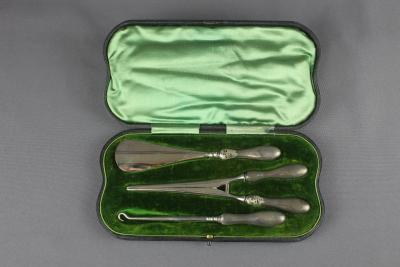FAN, HAND - WOOD WITH FLORAL DESIGN
c. 1930 - 1975Wooden fan with painted colour floral design . Light brown wooden fan with fifteen slats with tape running through two holes on each slat to hold fan together at top. Bottom of slats has a stud hinge with a metal loop on it. Flowers are painted purple, yellow, pink and blue with green leaves on left hand side, single pink flower with green leaves on right hand side. Outer two slats slightly darker.
Believed to have been owned by Miss Marjorie 'Joy' Roberts who was born in Kelmscott in 1917 and lived in the community her entire life. It is not known where she acquired the fan. Joy donated the fan to History House in 1975. Joy was a member of the Armadale Kelmscott Historical Society and donated the fan to help the society build a collection of items for the museum which opened the following year.
The folding fan is believed to have been developed in Japan during the 6th century C.E. Over the next five hundred years it spread across parts of Asia including China. In the 1500s regular trade between Europe and China started and the folding fan was introduced to Europe. The fan quickly became a highly sought after ornate and expensive fashion accessory for women in European royal courts. In the 1700s the fan was no longer the exclusive property of the elite. Mass produced cheap fans became available, made in Europe and China. At the start of the 1800s the fan fell out of fashion. In the 1820s the fan came back into fashion and was often designed to match or from the same fabric as the dress. Many fans from this period were large and highly decorated with romantic scenes from the 17th and 18th centuries.
In the 1900s fans remained in fashion but they became smaller and more delicate to match the changing fashion. The fan also became restricted to use with evening wear. By the 1920s though the fan was once again out of fashion. Fans were something for older women to use or were used as part of advertising campaigns. Through Asia fans remained popular during this time and continue to be popular today.
Details
Details
This object is part of a collection of items associated with a person or family who have played a significant role in the economic, community or social development of the City of Armadale. This can include holding key political or social positions within the community, being a key contributor or member of a community organisation, a strong contributor to improving the well-being of the local community, a prominent figure in a local business or industry, developer of new industries or activities or someone who grew up in the area and moved away and had a noteworthy career or life.

